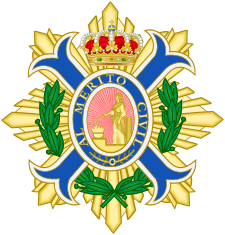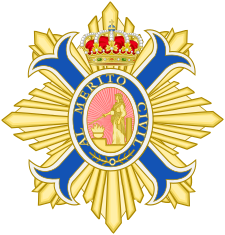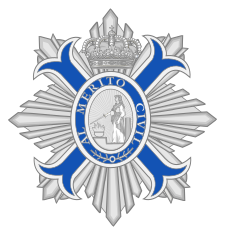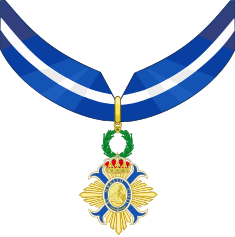Order of Civil Merit facts for kids
Quick facts for kids Order of Civil MeritOrden del Mérito Civil |
|
|---|---|
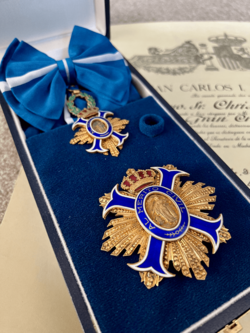
Grand Cross set of insignia of the Order
|
|
| Awarded by the Spanish Monarch | |
| Type | Civil Order |
| Established | 1926 |
| Royal house | House of Bourbon-Spain |
| Awarded for | Service to the State, the Provinces and Municipalities |
| Status | Currently Constituted |
| Grand Master | King Felipe VI |
| Grand Chancellor | José Manuel Albares, Minister of Foreign Affairs |
| Chancellor | Undersecretary of Foreign Affairs |
| Grades | Collar Grand-Cross Commander of Number Commander Officer Cross Cross Silver Cross |
| Precedence | |
| Next (higher) | Order of Isabella the Catholic |
| Next (lower) | Civil Order of Alfonso X, the Wise |
The Ribbons of the Order |
|
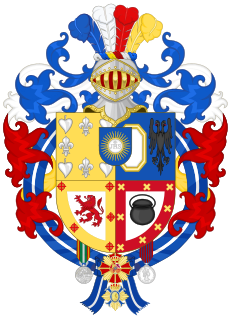
The Order of Civil Merit (Spanish: Orden del Mérito Civil) was established by King Alfonso XIII of Spain in 1926. The order recognizes "the civic virtue of officers in the service of the Nation, as well as extraordinary service by Spanish and foreign citizens for the benefit of Spain."
Contents
History
According to Basic Norms on Protocol & Decorations
The Order of Civil Merit was established by King Alfonso XIII of Spain, by Royal Decree on 25 June 1926, after the proposition of the President of the Council of Ministers, General D. Miguel Primo de Rivera (1870–1930). Its first regulations was published next 25 May 1927.
This Order was created to reward civic virtues of the functionaries in service for the State, the Provinces and Municipalities, as well as extraordinary services performed by Spanish citizens for the good of Nation, and could possibly be awarded, moreover, to foreign citizens by courtesy or reciprocity.
At the origin, it consisted of five categories:
- Grand Cross (Gran Cruz)
- Commander by Number (Comendador de Número)
- Commander (Comendador)
- Knight (Caballero)
- Silver Cross (Cruz de Plata)
Entry into the Order was conferred by the King, upon proposition of the Minister of State, requiring the agreement of the Council of Ministers when it concerned the concession of the Grand Cross, instructing them in all cases a demonstrative record of the justification of the award and issuing appointments and diplomas by the Section of Foreign Ministry and Orders of the Ministry of State.
The Provisional Government of the Republic, by decree of 24 July 1931, abolished this order and other orders of the State, except that of Isabel the Catholic, and wanted to replace them with the creation of the Order of the Republic.
Saved this interregnum, by Decree of 7 November 1942 restores the Order of Civil Merit, with his previous features, privileges and seniority, with the following categories: Grand Cross, Cordon (designation of the Grand Cross when given to women), Commander of Number, Commander, Officer, Knight, Knot (name of degree Knight when given to women) and Silver Cross, approving its rules by decree of 3 February 1945.
Subsequently, by decree of 26 July 1957, the Knight of the Collar category is established in the Order of Civil Merit, as the highest distinction of the Order. This high level is reserved to decorate Sovereigns and Heads of State and, exceptionally, to those, enjoying relevant significance, who are already in possession of the Grand Cross of the Order.
The great changes since that date, both in the social and political reality of Spain, and in the legal and administrative system, have been advised to update the rules governing the Order respecting the spirit that inspired its creation and preserving its seniority and their order of priority among the other Spanish Orders.
Thus, by Royal Decree 2396/1998 of 6 November 1998, published in the Boletín Oficial del Estado 279 of 21 November 1998 (and subsequent correction published in the BOE 40 of 16 February 1999), the approval of the new regulations proceeded, bringing together in one legal text all regulations which were scattered.
Among the most notable elements of the new regulation, one may mention suppression of the names of the degrees of Lady's Cordon, Knight's Cross and Dame's Knot, joining the first in that of Grand Cross, and creating the degree of Cross, including the two others, to avoid interpretations that would consider the maintenance of these designations may involve some form of discrimination based on gender.
Furthermore, it empowers the decorated women, for aesthetic and functional reasons (given the characteristics of their gala dress), to use miniature versions of the insignia, and to hang them differently from the men, as specified for each grade in the new regulation.
Two new forms of badges in the degree of Commander were regulated to grant awards to juridical persons: the Tie, for institutions that have recognized the use of flags or similar ensigns, and the Badge of Honour for institutions that do not possess these emblems.
Finally, in order to lend prestige to the distinctions of this Order and ensure that each is properly justified, the current regulation makes a detailed discussion of the merits to be considered for grant, of formal requirements to be met by proposals for entry and promotion within the Order, stating the legitimate authorities to do them, and reporting procedures that can be instructed in order to determine the suitability of granting.
Grades
The ribbon of the order is blue with a narrow white centre stripe, except for the ribbon of "Collar", which is blue with 2 white stripes on the edges.
The Order of Civil Merit comes in seven classes as follows:
- Collar (Collar) - Order's Collar.
- Grand Cross (Gran Cruz) - Sash and Plaque (Golden Order's Star).
- Commander by Number (Encomienda de Número) - Plaque (Silver Order's Star).
- Commander (Encomienda) - Golden order's star on a necklet.
- Officer's Cross (Cruz de Oficial) - Golden order's cross hanging from a ribbon.
- Knight's Cross (Cruz) - Silver order's cross hanging from a ribbon.
- Silver Cross (Cruz de Plata) - Simpler silver cross hanging from a ribbon.
| Insignia | ||||||
| Collar | Collar Grade Star | Grand Cross Star | Commander by Number Star | |||
| Commander | Officer's Cross | Knight's Cross | Silver Cross | |||
Notable recipients of Collar or Grand Cross
The Collar and Grand Cross of the Order have been awarded to royalty, heads of state and their spouses, and diplomats, including:
Heads of state
- 2023:
 João Lourenço and Ana Dias Lourenço, president and first lady of the Angola
João Lourenço and Ana Dias Lourenço, president and first lady of the Angola - 2021:
 Moon Jae-in and Kim Jung-sook, president and first lady of the Republic of Korea
Moon Jae-in and Kim Jung-sook, president and first lady of the Republic of Korea - 2015:
 Mohamed Ould Ahmed Salem Ould Mohamed Rare interior minister of Mauritania
Mohamed Ould Ahmed Salem Ould Mohamed Rare interior minister of Mauritania - 2012:
 Felipe Calderón Hinojosa, president of Mexico
Felipe Calderón Hinojosa, president of Mexico - 2009:
 Sir Kenneth Hall and Lady Rheima Hall, governor-general and first lady of Jamaica
Sir Kenneth Hall and Lady Rheima Hall, governor-general and first lady of Jamaica - 2010:
 Petro Poroshenko, president of Ukraine (then minister of foreign affairs)
Petro Poroshenko, president of Ukraine (then minister of foreign affairs) - 2008:
 Khalifa bin Zayed Al Nahyan, president of the United Arab Emirates
Khalifa bin Zayed Al Nahyan, president of the United Arab Emirates - 2007:
 Roh Moo-hyun and Kwon Yang-suk, president and first lady of the Republic of Korea
Roh Moo-hyun and Kwon Yang-suk, president and first lady of the Republic of Korea - 2003:
 Georgi Parvanov and Zorka Parvanova, president and first lady of Bulgaria
Georgi Parvanov and Zorka Parvanova, president and first lady of Bulgaria - 2003:
 Ion Iliescu, president of Romania
Ion Iliescu, president of Romania - 2003:
 Islom Karimov, president of Uzbekistan
Islom Karimov, president of Uzbekistan - 2002:
 Abdelaziz Bouteflika, president of Algeria
Abdelaziz Bouteflika, president of Algeria - 1999:
 Petar Stoyanov and Antonina Stoyanova, president and first lady of Bulgaria
Petar Stoyanov and Antonina Stoyanova, president and first lady of Bulgaria - 1996:
 Leonid Kuchma and Lyudmila Kuchma, president and first lady of Ukraine
Leonid Kuchma and Lyudmila Kuchma, president and first lady of Ukraine - 1995:
 Mahathir Mohamad, prime minister of Malaysia
Mahathir Mohamad, prime minister of Malaysia - 1994:
 Fidel V. Ramos and Amelita Ramos, president and first lady of the Philippines
Fidel V. Ramos and Amelita Ramos, president and first lady of the Philippines - 1993:
 Zhelyu Zhelev and Maria Zheleva, president and first lady of Bulgaria
Zhelyu Zhelev and Maria Zheleva, president and first lady of Bulgaria - 1994:
 Maaouya Ould Sid'Ahmed Taya and Aïcha Mint Ahmed Tolba, president and first lady of Mauritania
Maaouya Ould Sid'Ahmed Taya and Aïcha Mint Ahmed Tolba, president and first lady of Mauritania - 1988:
 Bacharuddin Jusuf Habibie, president of Indonesia
Bacharuddin Jusuf Habibie, president of Indonesia - 1979:
 Félix Houphouët-Boigny, president of Côte d'Ivoire
Félix Houphouët-Boigny, president of Côte d'Ivoire - 1978:
 Saddam Hussein, then vice president of Iraq
Saddam Hussein, then vice president of Iraq - 1968:
 Habib Bourguiba and Wassila Ben Ammar, president and first lady of Tunisia
Habib Bourguiba and Wassila Ben Ammar, president and first lady of Tunisia - 1968:
 Habib Bourguiba Jr., minister of foreign affairs of Tunisia
Habib Bourguiba Jr., minister of foreign affairs of Tunisia - 1965:
 Chiang Kai-shek, president of the Republic of China
Chiang Kai-shek, president of the Republic of China - 1957:
 Camille Chamoun, president of Lebanon
Camille Chamoun, president of Lebanon
Foreign royalty
- 2023
 Prince Joachim of Denmark
Prince Joachim of Denmark - 2023
 Princess Marie of Denmark
Princess Marie of Denmark - 2021:
 Prince Daniel, Duke of Västergötland of Sweden
Prince Daniel, Duke of Västergötland of Sweden - 2021:
 Princess Sofia, Duchess of Värmland of Sweden
Princess Sofia, Duchess of Värmland of Sweden - 2021:
 Prince Carl Philip, Duke of Värmland of Sweden
Prince Carl Philip, Duke of Värmland of Sweden - 2008:
 H.H.E. Sheikh Sabah Al Ahmed Al Sabah of Kuwait
H.H.E. Sheikh Sabah Al Ahmed Al Sabah of Kuwait - 2008:
 Crown Prince Mohammed bin Zayed of Abu Dhabi
Crown Prince Mohammed bin Zayed of Abu Dhabi - 2006:
 Princess Märtha Louise of Norway
Princess Märtha Louise of Norway - 2000:
 King Mohammed VI of Morocco
King Mohammed VI of Morocco - 2000:
 Princess Astrid of Belgium
Princess Astrid of Belgium - 2000:
 Prince Lorenz of Belgium
Prince Lorenz of Belgium - 2000:
 Prince Laurent of Belgium
Prince Laurent of Belgium - 1999:
 Princess Alia and husband Mohammad Al-Saleh of Jordan
Princess Alia and husband Mohammad Al-Saleh of Jordan - 1995:
 King Ja'afar Yang di-Pertuan Agong of Malaysia
King Ja'afar Yang di-Pertuan Agong of Malaysia - 1995:
 Queen Najihah Raja Permaisuri Agong of Malaysia
Queen Najihah Raja Permaisuri Agong of Malaysia - 1966:
 King King Faisal of Saudi Arabia
King King Faisal of Saudi Arabia - 1962:
 King Saud of Saudi Arabia
King Saud of Saudi Arabia - 1960:
 King Rama IX of Thailand
King Rama IX of Thailand - 1955:
 Princess Dina of Jordan (then queen)
Princess Dina of Jordan (then queen)
Others
- 2018:
 Monirul Islam
Monirul Islam - 2017:
 State Minister Nasrul Hamid of Bangladesh
State Minister Nasrul Hamid of Bangladesh - 2017:
 Ignacio Echeverría
Ignacio Echeverría - 2015:
 Sushma Swaraj minister of External Affairs of India
Sushma Swaraj minister of External Affairs of India - 2013:
 Fadi Al-Atrash Joumblatt
Fadi Al-Atrash Joumblatt - 2009:
 Amancio Ortega
Amancio Ortega - 2007:
 Miriam Defensor Santiago
Miriam Defensor Santiago - 2005:
 Abderrahim Harouchi
Abderrahim Harouchi - 1982:
 Germán Arciniegas
Germán Arciniegas - 1973:
 Ricardo Armando Novoa Arciniegas
Ricardo Armando Novoa Arciniegas - 1948:
 J. Hunter Guthrie
J. Hunter Guthrie
Gallery
See also
 In Spanish: Orden del Mérito Civil (España) para niños
In Spanish: Orden del Mérito Civil (España) para niños



